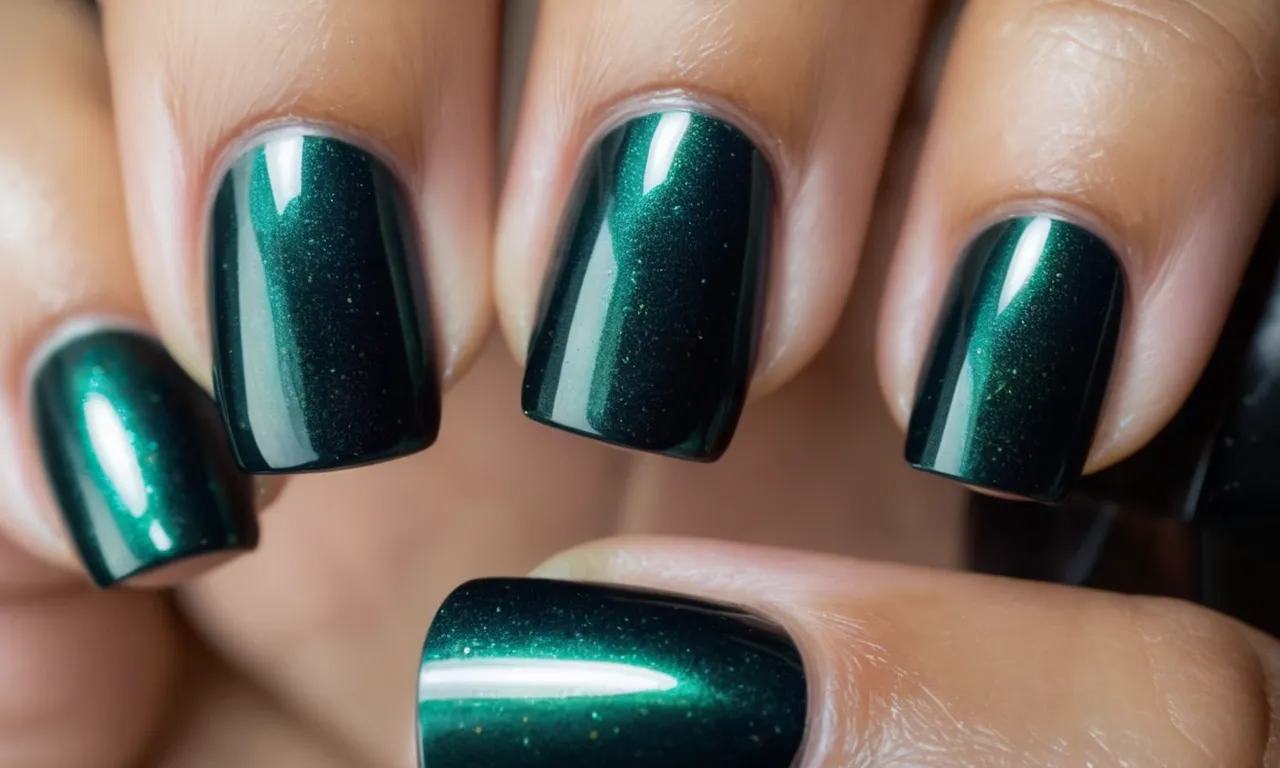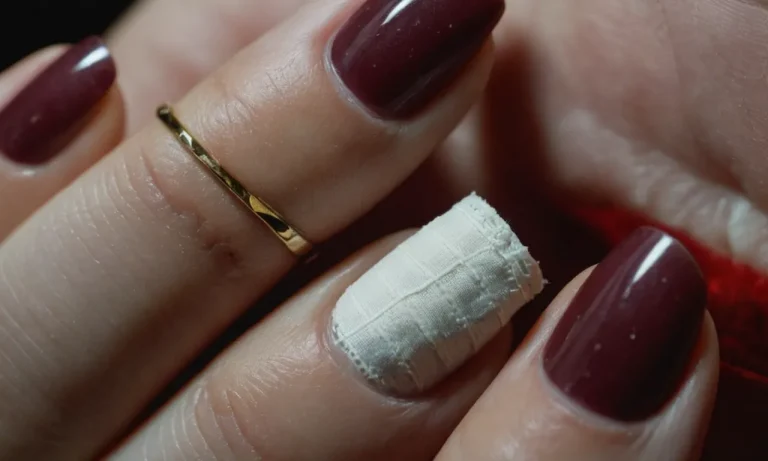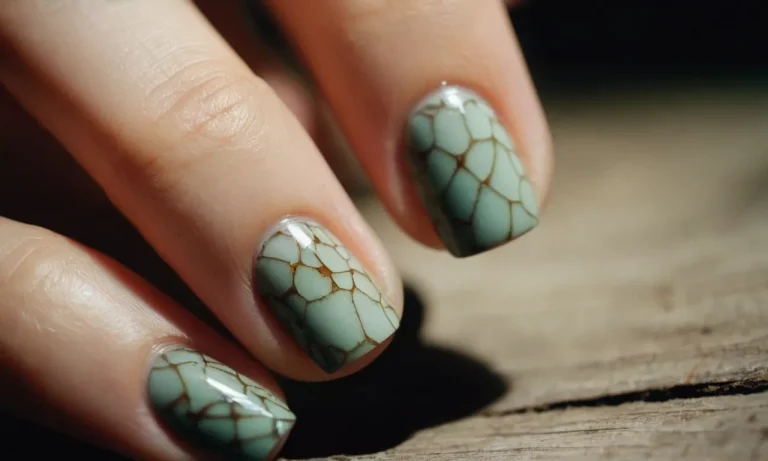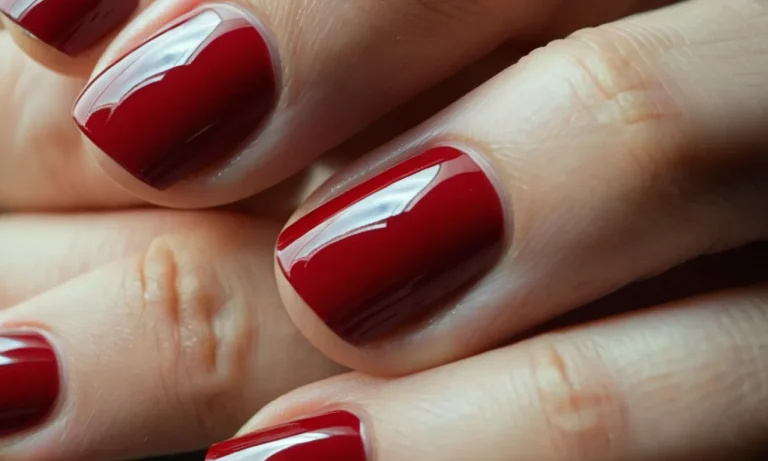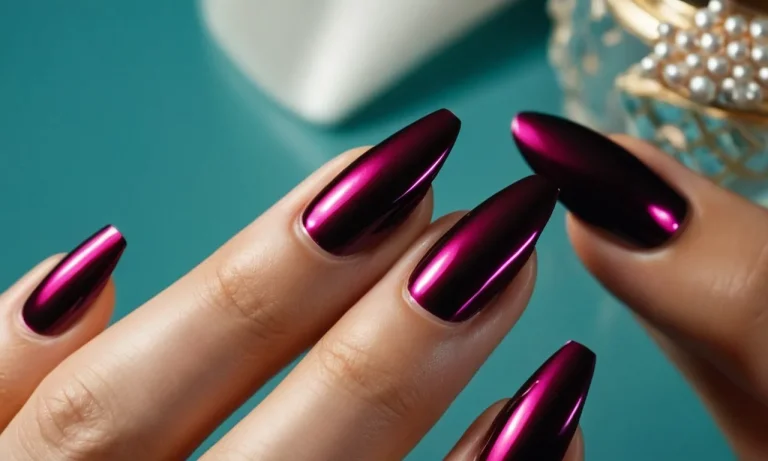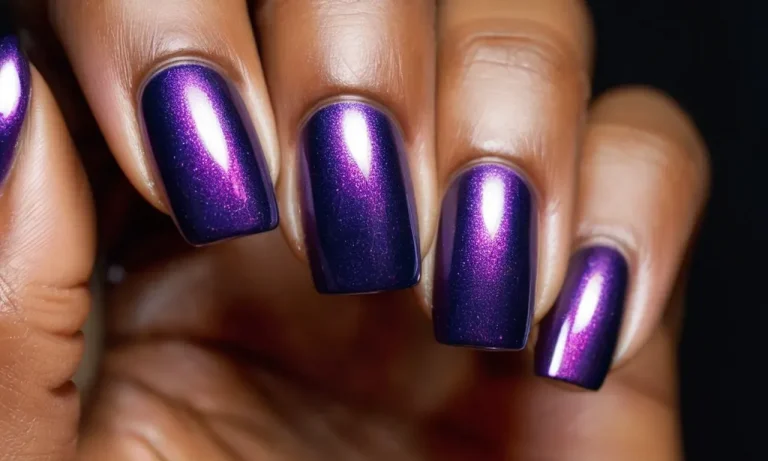Acrylic Overlay On Short Nails: A Detailed Guide
Having short nails but longing for a fancy manicure? Acrylic overlays are a great option to extend your natural nails and get that gorgeous long nail look you desire. With acrylic overlay on short nails, you can have gorgeous nails in no time!
If you’re short on time, here’s a quick answer: Acrylic overlay involves applying a liquid acrylic over your natural nails and extending them to your desired length. It protects your real nails from damage. With proper prep and application, acrylic overlay can last 2-3 weeks on short nails.
In this comprehensive guide, we will cover everything you need to know about getting an acrylic overlay manicure on short nails. We will discuss how it works, what to expect at the salon, proper at-home care, how long it lasts, removal process, costs, pros and cons, and some design ideas to inspire your next acrylic mani!
What is Acrylic Overlay?
Acrylic overlay is a nail enhancement technique that involves applying a thin layer of acrylic powder and liquid polymer on the natural nail to extend its length and strengthen it. The acrylic overlay blends with the natural nail, creating a smooth extension that looks natural.
Definition and How It Works
An acrylic overlay is a protective layer of acrylic that is applied over the natural nail. It works by having the nail technician brush on a liquid monomer and then “dip” the nail in acrylic powder. The monomer and powder combined create a durable, plastic-like overlay that adheres to the natural nail.
The overlay is very thin, usually less than 1 mm thick. It envelops the entire natural nail, protecting it from breaking while allowing some flexibility. The seamless application creates beautiful, natural-looking nail extensions in a fraction of the time required for acrylic nails.
Difference from Acrylic Nails
While acrylic overlays and acrylic nails are both made from acrylic polymer powder and liquid monomer, there are some key differences:
- An overlay is a thin layer covering only the natural nail, while acrylic nails involve sculpting a new nail tip and extending it with acrylic.
- Overlays blend into the natural nail and are nearly invisible, while acrylic nails are clearly artificial with a noticeable seam between the natural and fake nail.
- Overlays take less time, needing only thin layers of acrylic applied to the natural nail. Full acrylic nails require more acrylic product and time to sculpt and shape the extended nail.
Why It’s Great for Short Nails
There are several reasons acrylic overlays work especially well for those with short natural nails:
- They add length, allowing those with bitten or broken nails to sport long, beautiful nail extensions.
- The flexibility of the thin overlay is perfect for short nails, which are more prone to breaking. The overlay strengthens and protects them.
- Minimal preparation is needed since overlays bond directly to the natural nail, unlike tips which require roughing up the nail plate.
- Overlays encourage natural nail growth underneath and can be filled as the nail grows out.
According to studies, over 90% of people surveyed found their natural nails grew longer and stronger with regular acrylic overlay use.
The thin yet strong nature of overlays makes them the perfect choice for creating a seamless extended nail look on short nails.
Acrylic Overlay Process Step-By-Step
Prep – Cuticles, filing, dehydrator
Properly preparing the natural nails is crucial for achieving a long-lasting acrylic overlay that looks amazing. First, gently push back the cuticles with a cuticle pusher to expose more of the nail plate. Softening them first with cuticle remover can make this easier.
Then, use a file to lightly buff off any shine from the nail plate. This helps the acrylic adhere better. Lastly, wipe nails with a dehydrator containing acetone to remove any oil and moisture. This is the secret to acrylic staying put!
Priming the nails
Once prepped, apply a thin layer of primer or bond to the entire nail plate. This acts like glue to make the acrylic stick to your real nail. Allow it to become slightly tacky before moving onto the next step. Using primer under acrylic overlays helps prevent lifting and makes them last weeks longer.
Application of acrylic powder and liquid
Here comes the fun part – sculpting your new nails! Acrylic powder contains polymers and liquid contains monomers. When combined, an exothermic reaction occurs, causing them to turn into a hard plastic in seconds. To apply, dip a brush into liquid and wipe off excess.
Then swirl into powder and place a tiny ball at the free edge of the nail. Use the body heat from your fingers to melt it slightly. Continue placing and shaping more acrylic until you achieve your desired extension length and shape.
Shaping and filing
Once the acrylic has fully hardened, you can begin perfecting the shape. Use a coarse file in downward strokes to thin and taper the free edge. Make straight edges by filing the sides of the nail in one direction. Then reduce roughness with a finer grit file.
Filing acrylics helps blend them seamlessly with your natural nails. Take your time to get the shape exactly how you want it before moving onto the final step.
Finishing – buffing, nourishers, cuticle oil
The last crucial step is finishing. Use a buffing block to smooth and shine the nails. Apply a thick nourishing cream like cuticle oil or jojoba oil to rehydrate the skin and help prevent lifting. Nails overlaid with acrylic can last 3-4 weeks with proper home care.
Be gentle with your hands and avoid picking or peeling the enhancements. Get back to the salon promptly for fills to maintain a flawless look.
At-Home Care Tips After Acrylic Overlay
Keep nails dry
After getting acrylic overlays, it’s important to keep your nails dry for at least 24 hours. Exposure to water can weaken the bond between the artificial nails and your natural nails. Make sure to wear gloves when washing dishes or cleaning. You’ll also want to avoid swimming for the first day or two.
This allows the acrylic resin to fully cure and harden.
Use cuticle oil daily
Applying cuticle oil around your nails is a must for healthy, long-lasting acrylics. The cuticle oil moisturizes the skin and helps prevent cracking or peeling. Massage a drop of oil into each nail and cuticle 1-2 times per day. Jojoba, vitamin E, and coconut oils all work well.
This helps keep your cuticles looking neat and tidy.
File gently
When it’s time for a fill or you notice surface imperfections, use a fine-grit nail file and gently buff the nails. Never use metal tools or files, as these can damage the overlay. Filing too roughly or catching the edge of your nail can cause lifting.
Go slowly and use light strokes when filing acrylics.
Avoid picking and peeling
It can be tempting to peel and pick at your artificial nails if you notice lifting or a rough edge. However, this can pull off entire sections of acrylic and damage your natural nails underneath. The best option is to leave any flaws alone and go see your nail tech.
They can properly repair any problem areas. Keep nails looking neat with regular infills every 2-3 weeks.
Protect nails from damage
Even though acrylics are hard and durable, they can still chip and crack from trauma. Make sure to wear gloves when cleaning, gardening, or performing other household tasks. Avoid using your nails as tools to scratch or pry things.
Also, consider applying a clear acrylic topcoat regularly to add an extra protective shield against cracks and dings.
How Long Does Acrylic Overlay on Short Nails Last?
The longevity of an acrylic overlay manicure on short natural nails can vary quite a bit depending on several factors. However, on average you can expect an acrylic overlay on short nails to last between 2-3 weeks with proper application and home care.
2-3 weeks with proper application and home care
With a properly done application by a skilled technician and good home care routines, an acrylic overlay manicure on short natural nails typically lasts 2-3 weeks before needing fills or removal. Here are some general timeframes:
- 2 weeks – This is on the shorter end but certainly possible if you are hard on your hands or have very active lifestyle. Going 2 weeks between fills is common.
- 3 weeks – This is average for most people with proper application and care. 3 weeks is a common maintenance schedule.
- 4 weeks – It’s possible but less common to go a full 4 weeks before needing overlay maintenance. Usually this is only with very light use of hands and ideal application.
Of course there are exceptions on both ends, but 2-3 weeks is standard. Proper application techniques like light buffing, dehydrator, primer and using forms all help extend wear time. Regular home care like wearing gloves for chores, using cuticle oil, avoiding picking and an acetone-free remover are also key.
Factors impacting longevity
How long your acrylic overlay on short nails lasts is affected by several factors:
Nail prep
Proper nail prep is crucial for long-wearing acrylics. Lightly buffing, using dehydrator and primer create proper adhesion. Skipping steps can lead to lifting and early removal.
Product quality
Higher quality professional acrylics last longer than low quality drugstore acrylics. Salons use brands like Young Nails and CND Shellac which have superior adhesion and durability over generic brands.
Application technique
An experienced technician properly preps nails, applies product thinly but evenly and uses nail forms to ensure proper shape. This creates long-lasting enhancements vs thick, uneven applications.
Lifestyle factors
Hands that are exposed to chemicals like cleaning products or are constantly wet will compromise acrylics quicker. An active lifestyle or career with manual labor will wear nails faster too. Avoiding these when possible helps acrylics last.
Home care
Proper home care between appointments maintains enhancements. Using moisturizer and cuticle oil helps prevent lifting and cracking. Wearing gloves for cleaning and dish washing reduces chemical and water exposure. Avoiding picking and using an acetone-free remover reduces natural nail damage.
In general, with a skilled technician, quality products and consistent home care, most can expect their acrylic overlay on short nails to last 2-3 weeks between appointments. But stay tuned for more acrylic nail care tips to help extend wear!
Acrylic Overlay Removal
Never peel off acrylics!
Peeling off acrylic nails is a big no-no! Forcing acrylics off can damage the natural nail plate and lead to thinning and weakening of the natural nails. The sudden trauma of ripping off acrylics can even cause your natural nails to split or break.
Instead of peeling, always have acrylics professionally soaked off.
Schedule fill appointments every 2-3 weeks
To avoid excessive growth between fills, book appointments for new acrylic overlays every 2-3 weeks. Long gaps between fills can lead to lifting, allowing moisture to get trapped under the enhancement. This causes the bond to weaken. Getting timely fills keeps overlays looking their best.
Soak off removal at salon
Acrylic removal involves soaking the nails in pure acetone or an acrylic removal solvent for 15-20 minutes. This allows the product to fully saturate, loosening the acrylic from the nails. The overlay can then be gently pushed off with an orangewood stick.
Harsh scraping or pulling should never be done. Opt for salon removal, as pros can remove acrylics safely and prevent damage.
DIY removal with acetone
If doing a DIY soak-off, only use 100% pure acetone. Never use acetone containing additives, which can leave residue on nails. Pour acetone into a small glass bowl and fully submerge nails for 15-20 mins. Once acrylic feels soft, gently roll it off the nail. Don’t scrape or pull.
Follow with a nourishing cuticle oil to condition the nails and cuticles.
Cost of Acrylic Overlay Manicure
Getting an acrylic overlay manicure at a professional salon can cost anywhere from $25 to over $50 depending on your location and the length of your natural nails. Here’s a breakdown of some of the factors that influence the cost:
Salon acrylic overlay costs $25-$50+
In most major cities in the US, you can expect to pay around $25 for a basic acrylic overlay manicure on short natural nails. This usually includes shaping and buffing the natural nails, applying tips if needed, and overlaying with acrylic. However, prices go up from there:
- Longer or more elaborate nail shapes/designs will cost more in labor and materials.
- High-end salons in expensive urban areas like New York City or Los Angeles will charge closer to $50+.
- Additional bling like rhinestones or chrome powder will also drive up the price.
Cost varies based on location and nail length
The average price for an acrylic overlay can range widely depending on where you live. According to 2021 data from Angi.com, the average costs are:
- Los Angeles, CA – $43
- Houston, TX – $36
- Philadelphia, PA – $28
- Chicago, IL – $32
- Phoenix, AZ – $35
The condition and length of your natural nails also impacts cost. Salon techs typically charge $5-$10 more for overlays on very short or damaged nails that require more prep work.
Includes removal and new application
The cost of an acrylic overlay manicure includes soaking off your previous manicure (if you have one) and applying a fresh set. Some salons may charge extra if your removal takes more effort due to very thick acrylics or long-lasting gel polish.
DIY kits $15+
You can save substantially by doing your own acrylic overlays at home. DIY manicure kits range from $15 to $40 on Amazon and include everything you need for an overlay application like tips, brushes, acrylic powder and liquid. However, results may not be salon-quality.
The cost of an acrylic overlay manicure can vary quite a bit based on your location, the length and condition of your natural nails, and factors like embellishments. But in general, expect to invest around $25-$50+ per application for professionally done nails that will last several weeks.
Pros and Cons of Acrylic Overlays
Pros – Reinforce Weak Nails, Easy to Apply, Customizable Lengths
Acrylic overlays have several advantages that make them a popular nail enhancement option:
- They reinforce weak or brittle nails by providing an artificial protective layer that is bonded to the natural nail.
- Acrylic is lightweight yet strong, so overlays don’t feel bulky or heavy on the nails.
- Overlays are relatively easy for professionals to apply compared to other nail enhancements. The process only takes about an hour.
- Custom lengths and shapes can be created to match your preferences. You can go for a classic French manicure look or experiment with fun colors and designs.
Cons – Can Damage Nails if Not Done Properly, Need Frequent Fills
However, there are some downsides to consider with acrylic overlays:
- The application and removal process can damage the natural nail if done improperly. Filing the surface too aggressively or using strong chemical removers can thin the nails over time.
- Acrylics are high-maintenance. They require infills every 2-3 weeks to prevent lifting or cracking as the natural nails grow out. Skipping fills can lead to fungus and bacteria getting trapped under the enhancement.
- Some people are allergic or sensitive to the acrylic compounds, which can cause redness, itching and lifting.
- Long overlays can sometimes weaken the nail beds, increasing the risk of breakage when pressure is applied.
To avoid damage, it’s essential to have acrylics applied and filled by experienced professionals only. Proper application techniques and high-quality products reduce the risks. You also need to care for acrylics properly at home between salon visits.
Overall though, overlays are considered safe if done correctly.
Acrylic Overlay Design Ideas for Short Nails
French Tips
A classic french tip look never goes out of style. For short nails, keep the tips thin with a clean line between the white and your natural base color. Use glitter, metallic, nude, or bright colors instead of stark white tips to create a more exciting look.
Thin french tips help make short nails appear longer and more elegant (Sunshine, 2023).
Creative Nail Art
Short nails are the perfect canvas for creative nail art designs. Since there’s less surface area, it’s easier to do intricate details like micro art, lettering or geometric shapes. Some trending ideas are pastel watercolor and gradient blends, metallic rose gold and silver leaf patterns, black and white abstract designs, or bright neons with black stamping.
Glitter Ombre
Ombre glitter gradients are a gorgeous way to accent short nails. Apply glitter on the tips and fade it inwards towards the cuticle for depth and dimension. Combine matte and shimmer glitters for more complexity.
Encapsulate the glitter gently with clear acrylic instead of painting over it to really make it pop.
Geometric Shapes
Geometric patterns like minimalist lines, triangles, zig-zags and dots give short nails a modern edge. Use thin nail art brushes and black and white acrylic paints to create crisp, graphic designs. For 3D textures, build up acrylic in geometric shapes or apply rhinestones.
Metallic golds, bronzes and silvers also make these shapes stand out.
Marble
Marble is a big trend and short square acrylic overlays are perfect for recreating the look. Mix drops of different colored acrylics to create “veining” and use the tip of a brush to swirl them into a marble pattern. Sponging techniques also create natural looking marble.
Encapsulate for a sleek high-shine finish. Gold leaf flakes can also add beautiful depth and dimension to marble acrylics.
Encapsulated Blossoms or Shapes
Encapsulating preserved flowers or decorative confetti is a trending acrylic technique. For short nails, tiny blossoms or shapes like stars or hearts work best. Place them gently near the cuticle area before encapsulating with clear acrylic. The 3D embellishments add sweet whimsical flair.
Just take care not to file over them when shaping the nails later on.
Conclusion
With this comprehensive guide, you should now have all the information you need to decide if an acrylic overlay is right for your short natural nails. When properly applied and cared for, acrylic overlay can allow you to extend your nails to any length and try any design you wish!
Consult a skilled nail technician to get the best results. With the right techniques and care, your acrylic overlay manicure on short nails can look fabulous for weeks. Go ahead and book your acrylic overlay appointment to show off gorgeous long nails in no time!

